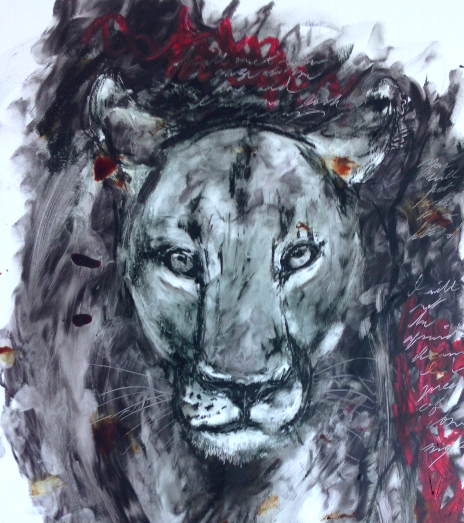
I have been thinking about lions a lot lately. Partly this is because of Melissa Bachman, and partly because I happen to be painting them at the moment, for my feminist wildlife art project. Lions are not afraid of the dark, and I envy them for it.
I met a lion called Sunshine once. It was in 1996, at Tshukudu near Hoedspruit, when I was researching a story on the emerging centre of South Africa’s game-farming industry. She was tame, kept in captivity, and when she came to show my brother and I her cubs her tail was up like a domestic cat coming to say hello. She was proud of her cubs, and pleased to see me. I made the mistake of reaching over and touching her on her flanks; it tickled, and she responded instinctively, snapping at me gently. “Don’t do that,” said her handler.
She playfully placed her canines around my brother’s kneecap and squeezed, ever so gently. Later my brother said he felt the power in those jaws; how, if she wanted, she could have bitten his leg off.
But Sunshine was a sweetheart who lived up to her name, and of all the lions I have ever met, Sunshine was the nicest.
I have loved lions all my life. At the age of 4, I played with cubs at the Lion Park, and it left a lasting impression on me. I have been lucky enough to see white lions in Timbavati. I have drawn and painted many, many lions over the years.
In the 1990s, we knew two magnificent brothers who ruled over the local pride. One of them was lured to the fence to be kidnapped for a Danish bow hunter. The Shangaan trackers traced the lion to a cage on a neighbouring farm, and he was rescued just in time.
I hated that Danish bow hunter with every fibre of my being.
For years, the farm that I visited bordered on a property that farmed canned lions and other species. Most days we’d go to look at the “hok leeus”. Once, I walked up to the fence and made a sudden movement without thinking.
It was like the moment in Life of Pi, where the boy looks into the tiger’s eyes and the father tells him that there is no soul there. There was no soul in these eyes, not in the sentimental sense. They were predators, and I was prey.
At the nature reserve where I am fortunate enough to spend time every year, I have known many of the wardens and rangers over the years. Shooting is part of what they do. If a baboon breaks into a camp one too many times, it is shot. When hunting permits are issued for buffalo and, yes, elephant, they are shot too.
On a walking tour in the Kruger National Park, the rangers told us about having to shoot buffalo who charged tourists. Elephant, they said, are negotiable, but not buffalo. They were matter of fact. When you live with wildlife, you live with the ever-present possibility that you will have to kill it before it kills you.
In the dead of night, lions are unafraid, something I am exploring in my latest art project. I envy them for that.
So this is my history with lions. I am not like Melissa Bachman, and other people who enjoy killing lions so that they can take them home and put them in their lounge (where do they find the room?) I criticised those who attacked her, and I stand by my views, but I can’t imagine doing what she did, and taking pleasure in shooting one.
It breaks my heart that this is what lions have come to. The species that holds more symbolic power than any other — that was once the most widespread large mammal after human beings, found from Africa to Siberia, to the Americas — now depends on fences and guns and dollars for its survival.
Is there any room in the world for lions?


